DACF Home → Bureaus & Programs → Maine Natural Areas Program → Communities, Plants, and Animals → Invasive Plants → Shrubby Honeysuckles
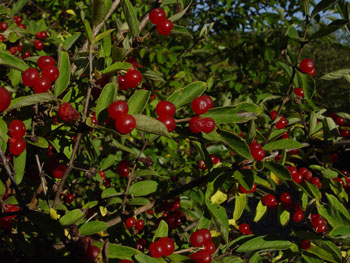 Lonicera morrowii fruit
Lonicera morrowii fruit
Shrubby Honeysuckles
Lonicera morrowii and Lonicera tatarica
2019 Status in Maine: Widespread. Severely Invasive.
Description: Perennial, deciduous shrub, up to ~10' tall and wide, usually very branched. Leaves: Simple, opposite, oval to egg-shaped, with blunt to pointed tip, 1-2" long, edges entire, may be hairy underneath. Leaves emerge early and are held late. Flowers: ~1" wide, paired in leaf axils, fragrant, tubular, creamy white, yellow, or pink. Bilaterally symmetrical, ½" long petals like "arms" extending in several directions. Appear in May in Maine. Fruit: Red, globular, juicy berry, to ~1⁄3" wide. Ripen by late summer in Maine. Stems: Larger plants have shaggy bark on lower stem. Larger twigs have hollow pith (tube in twig center, cut with sharp blade to see).
Native range: Asia. How arrived in U.S.: As an ornamental and for windbreaks.
Reproduction: By seed. Birds and mammals consume fruits and disperse seed. Seed longevity is not known but likely modest.
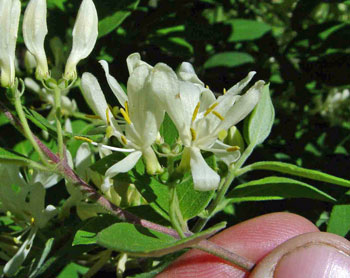 Lonicera morrowii flowers
Lonicera morrowii flowers
Habitat: Reaches largest size in sun but highly shade-tolerant and capable of invading intact forest understory. Grows in forests, edges, old fields, and roadsides. Tolerant of dry to wet soils, nutrient-poor soils.
Similar native species: Fly-honeysuckle (Lonicera canadensis) and mountain honeysuckle (Lonicera villosa) both have similar oval, paired leaves, but have solid pith and tubular flowers with short triangular petals, and are much shorter in height. Bush-honeysuckle (Diervilla lonicera) has solid pith and leaves with fine teeth which are long-pointed at the tip. All native honeysuckles (Lonicera spp.) have solid pith.
Similar non-native species: The invasive shrubby honeysuckles can be distinguished as follows: L. morrowii (white-yellow flowers) is finely hairy on leaf bottoms, L. tatarica (pink flowers) mostly lacks leaf hairs, and their hybrid L. x bella (light pink to white flowers) is somewhat hairy. Common snowberry (Symphoricarpos albus), another opposite-leaved shrub, has clusters of small pink flowers and forms large white berries.
Fact Sheets and Identification Links
- Vermont Fact Sheet for Shrubby Honeysuckles
- Vermont Invasive Honeysuckles vs Native Honeysuckles
- Friends of Acadia Identification Video (2:15)
- University of Wisconsin Identification Video (2:53)
- Go Botany page for Lonicera morrowii and for Lonicera tatarica
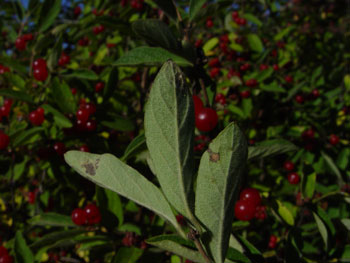 Lonicera morrowii leaf undersides
Lonicera morrowii leaf undersides
Control Methods
Small plants and seedlings may be pulled up by the roots when soil is moist; larger plants can be cut, but re-sprouting will occur.* Persistent cutting or burning the root crown multiple times during the growing season over several years may kill the plant, but diligence is required. Mowing can prevent seedlings from establishing. Goats and sheep will browse it but repeated, heavy damage over multiple years is required to kill established shrubs. Glyphosate† is the most effective herbicide for honeysuckles. They will hold on to their leaves into the fall which makes them susceptible to a foliar glyphosate application after many native species have dropped their leaves. For cut-stump application use glyphosate applied immediately after cutting except in early spring. Basal bark application is less effective on these species.
* Correctly dispose of all plant parts↵ † Follow all label directions when using herbicides↵Control Technique Video Demonstrations
- Southern Illinois (4:50), cut stump herbicide treatment
- Hemdon Environmental Network, Virginia (1:00), cut stump and herbicide treatment for the backyard gardener (5:00)
- Acadia National Park (1:00), time lapse removal
Please email invasives.mnap@maine.gov if you have questions about invasive species in Maine
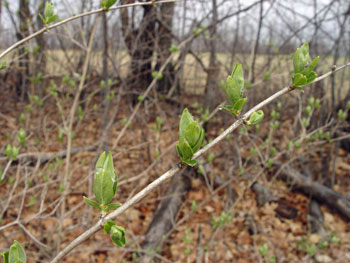 Lonicera morrowii leaf buds in early spring
Lonicera morrowii leaf buds in early spring
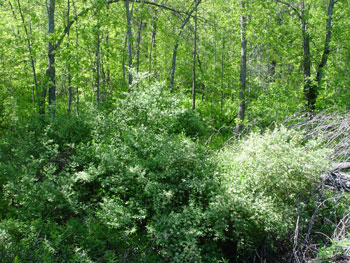 Lonicera morrowii in the forest understory
Lonicera morrowii in the forest understory
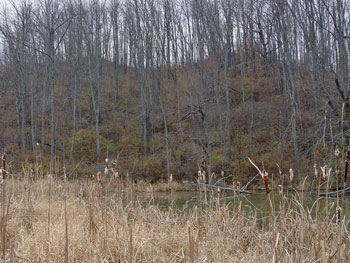 Lonicera morrowii early leaf out in the woods
Lonicera morrowii early leaf out in the woods
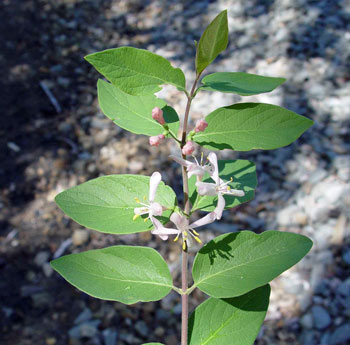 Lonicera morrowii stem with flowers
Lonicera morrowii stem with flowers